What to do if gooseberry berries are covered with a brown coating, how to save the harvest
To grow a good harvest of gooseberries, watering and dressing alone is not enough. It is important to regularly inspect shrubs for external damage - they signal diseases that have arisen. One of the most common signs of infection is brown spots on leaves, shoots and fruits. They indicate the appearance of powdery mildew, goblet rust, anthracnose or septoria on the bush.
The article will tell you what to do if there is a brown bloom on the leaves and berries of the gooseberry and how to cure diseased plants.
The content of the article
Why gooseberry berries are covered with a brown coating
Brown bloom on gooseberries is a sign of fungal and viral diseases. Plaque spreads locally or throughout the plant, depending on the degree of infection. Sometimes brown spots are caused by micronutrient deficiencies or improper rules landing and care.
Rust
Rust is easily recognized by brown-orange spots on flowers, stems and leaves. The main types of rust are goblet (manifested by swelling) or columnar (spots). A disease occurs due to high humidity, frequent watering, dense plantings.
Get rid of rust with contact fungicides or 1% Bordeaux liquid. First time gooseberry processed during the blooming of leaves, the second - at the time of budding. Finish processing after flowering.
Powdery mildew
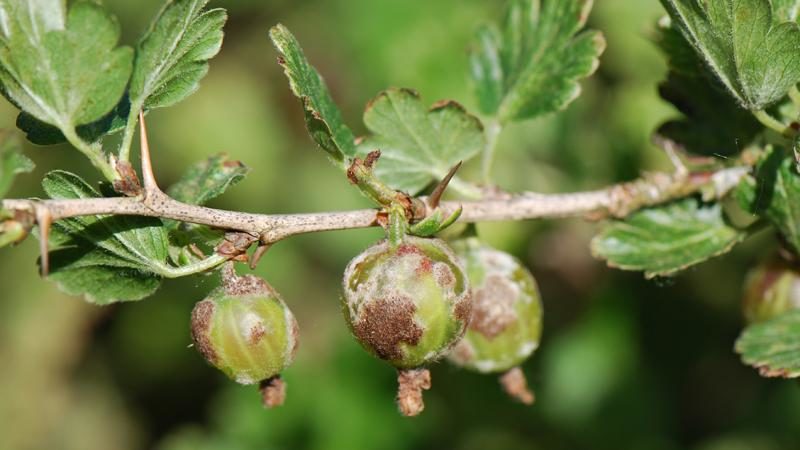
Powdery mildew is one of the most common diseases in horticultural crops. It affects all parts of the plant, actively manifests itself in late April - early May, when warm weather sets in. At first, the disease manifests itself as a white coating, which soon turns into blurry brown spots.
The affected shoots are deformed, the leaves dry out and bend, the fruits stop growing. As a preventive measure, ammonium nitrate is used against powdery mildew. For 10 liters of water there is 50 g of the drug, the resulting solution is moistened with leaves and shoots. Processing before flowering on a windless day.
Mosaic
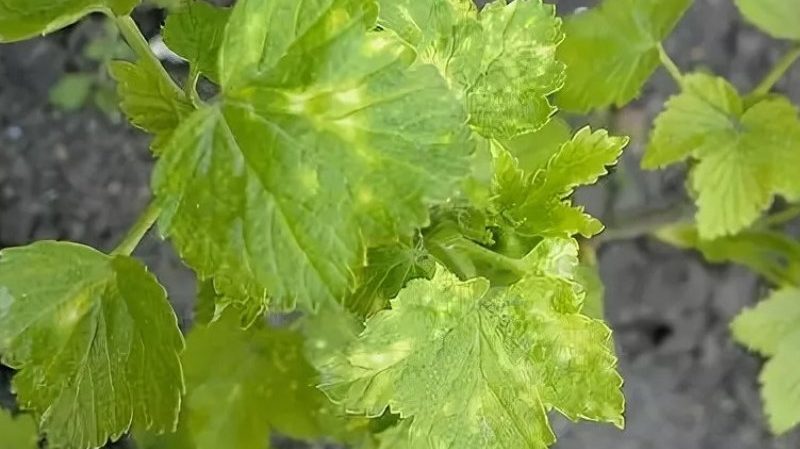
A viral disease occurs due to non-compliance with the rules of disinfection, heat and high humidity. Sometimes the cause of infection is insects and rodents, which carry the virus. Due to the mosaic, the leaves are covered with a bright yellow pattern that runs along the main veins.
Rain, dew and fog contribute to the disease. If the mosaic is not detected in time and measures are not taken, then the shrub slows down in development, and soon dies altogether. The causative agent of the mosaic is frost-resistant, quickly spread by the wind. The fight against this disease is carried out from early spring to late autumn.
Septoriasis
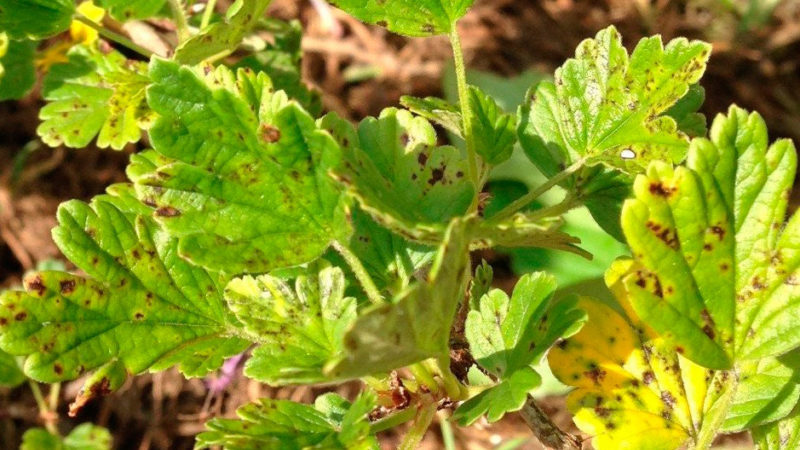
Fungal disease primarily affects the leaves - dirty gray spots with a brown border form on the plates. After 3-5 days, dark spots appear - these are foci of infectious spores. The leaves dry up and curl, after which they fall off.
If infected leaves are found, they are removed and burned. Otherwise, nearby plants will get sick. Septoria occurs due to weeds and fallen leaves, which store infected spores on themselves. That is why it is important to monitor the cleanliness of the soil and remove all weeds in time.
Anthracnose
Fungal spores overwinter on fallen leaves.The sign of anthracnose is small brown specks up to 1 mm in diameter, which appear on the leaves of the gooseberry. The latter quickly fall off, while anthracnose spreads to shoots and fruits.
The disease affects the leaf roots and stalks, which affects the yield. This happens especially actively in rainy weather. If measures are not taken in time, the disease will destroy up to 80% of the crop and infect other fruit trees and shrubs. Also, in bushes that are infected with anthracnose, the growth of young shoots is reduced.
Brown spots on gooseberry fruit
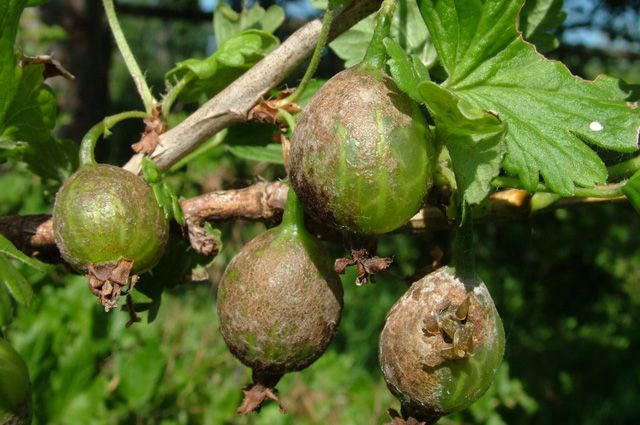
The most common cause of brown spots on berries is advanced powdery mildew.... In this case, it makes no sense to fight the disease, it is better to immediately remove the affected shrubs and burn them away from the garden plot.
The remaining plants are treated with Bordeaux liquid or copper sulfate solution. For prophylaxis in early spring, the bushes are watered with boiling water to destroy pathogenic microorganisms. It would be useful to spray the gooseberries with a solution of wood ash - for 10 water, 300 g of dry matter is required.
On the leaves
On the leaves, brown spots arise due to a lack of trace elements. Deficiency symptoms do not appear immediately, but after 1-2 months. The plant weakens and slows down in growth, leaves change color, fruit formation decreases, the root system weakens. The lack of trace elements is replenished by introducing into the soil humus or vermicompost. Complex garden fertilizers - "Zdraven", "Kemira Universal", "Argikola Green" will also come to the rescue. They will eliminate the deficiency of nitrogen, potassium, phosphorus.
Attention! The effectiveness of the fertilizer depends on the correct application. Gooseberries are fed before watering, after loosening the soil to a depth of 5-7 cm. After that it is moistened with warm water, directing it under the root. This promotes faster distribution of nutrients and improves their absorption.
What to do, how to save the gooseberry
Purchased and folk remedies help to fight fungal and viral diseases.
Purchased funds
Purchased items include chemical and biological products. Chemicals are used if the plant is already sick and the treatment requires effective measures. Biologics are more environmentally friendly and are used for both treatment and prevention.
Use "Gaupsin" against brown spots. The product has antimicrobial and fungicidal action, is effective against diseases and insect pests... Efficiency in the fight against pathogens is 90%, the drug is non-toxic to humans and animals. The product is diluted in water in a ratio of 1:50 and the solution is left for 30 minutes. Processing is carried out in the morning or in the evening at an air temperature of at least + 10 ° C. The action of "Gaupsin" is observed within 30 hours from the moment of spraying.
Effective in use and "Fitosporin"... It eliminates fungal and bacterial diseases, suppresses the reproduction of dangerous microorganisms. Gooseberries are processed in dry weather, the interval between procedures is from 7 to 14 days. Apply "Fitosporin" at any stage of plant development, including the growing season and fruiting. To prepare the working solution, use 10 l of water and 15 g of the drug.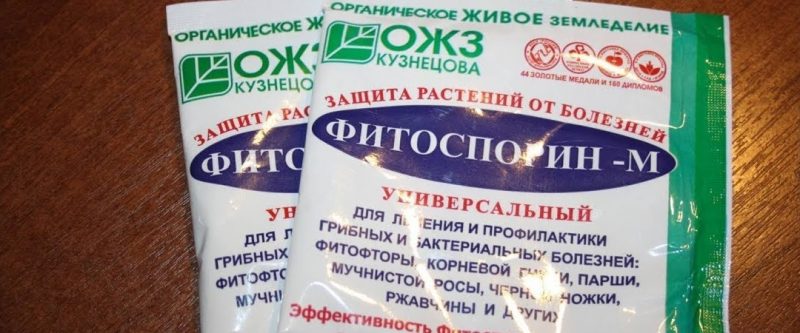
Attention! Summer residents also turn to Bordeaux liquid for help. It is used for treatment and prevention and is valid for 30 days from the date of processing. The procedures are carried out during the budding period and before flowering. A spray bottle is used for spraying.
Traditional methods
Folk remedies are used to prevent the appearance of brown spots. Most products are prepared from the available components:
- 20 g soda + 1 tab. aspirin + 10 g of liquid soap + 5 liters of water. The remedy helps against rust, powdery mildew and anthracnose. Summer residents carry out processing 1 time in 3 weeks.
- Mix 10 liters of boiling water with 3 kg of dry ash. Insist for a day and strain.Spray gooseberries at intervals of 2-3 weeks. Dilute the ash sediment with water and pour it over the plant.
- Mix 9 liters of water with 1 liter of sour kefir. Process the gooseberries every 3 days.
- Pour 200 g of onion husks with 10 liters of boiling water. Insist for two days, process the gooseberries before flowering.
- Mix 30 g of soda with 50 ml of liquid soap and dissolve in 10 liters of water. Carry out processing before and after flowering.
How to carry out the processing correctly
A dry day is chosen for processing. The best time is morning (after dew has dried) or evening (after sunset). If you spray gooseberries in the sun, the preparations dry out quickly and become less effective.
Weeds and leaves are removed before the procedure. If the bush is sprayed in the spring, then before that they must pruning, remove all old and diseased shoots. During the flowering period, it is prohibited to process the plant.
Attention! When using chemical or biological products, safety rules are observed. Before use, they study the information on the package, put on a protective suit - glasses, gloves and a respirator.
How to clean plaque
It is advised to wash the plaque from the gooseberry only if it appeared no more than one week ago. Typically, it occurs due to powdery mildew. At first, the bloom is light, it is at this moment that it makes sense to wipe the gooseberries with a damp clean cloth - the leaves and the stem, and then treat the bush with a solution of Bordeaux liquid or copper sulfate. After 4-5 days, the white bloom turns into brown. Such berries are not suitable for consumption.
You can also defeat white bloom with the help of manure. It is poured with water in a ratio of 1: 3 and insisted for 3 days. Gooseberries are watered at the root, it takes 1-2 liters per bush.
Resistant gooseberry varieties
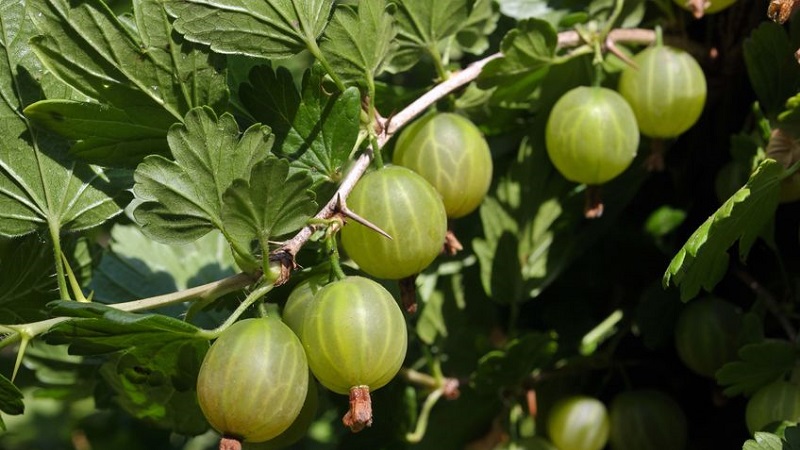
To facilitate gooseberry care, gardeners choose resistant varieties. For example, Malachite and White Nights varieties are popular for cultivation in the North-West region of the country. They are distinguished by immunity to fungal diseases, and are unpretentious in cultivation. 3-4 kg are harvested from one bush per season.
Salyut and Prune varieties are grown in the central region of Russia. Winter-hardy gooseberries, rarely affected by septoria, rust and powdery mildew. Any gardener manages to grow a tasty and juicy crop, the plant does not cause trouble.
In the southern regions of Russia, summer residents choose the varieties Kazachok and Serenade. Plants are drought tolerant, rarely damaged by pests and diseases. The yield of varieties is up to 5 kg per bush.
Preventive measures
In addition to choosing a variety, summer residents pay attention to prevention:
- keep a distance between the bushes of at least 2 m;
- plant gooseberries in a sunny and dry place;
- disinfect seedlings and garden soil with a solution of potassium permanganate;
- watered with boiling water in early spring;
- regularly loosen and mulch;
- the affected and weak branches are cut in the spring;
- form a crown;
- remove weeds and fallen leaves;
- bring in organic and mineral feeding;
- regularly inspect the gooseberries for damage.
Conclusion
So that the gooseberry does not get sick, attention is paid to preventive measures. Gardeners regularly remove weeds and loosen the soil; with the arrival of spring, they cut off the branches and form a crown. For protection, the plant is sprayed with soap or ash solution, watered with slurry.
If brown and brown spots have already appeared, summer residents use chemical or biological preparations. To get rid of diseases helps "Fitosporin", Bordeaux liquid, "Gaupsin". It is important to follow the instructions and follow the recommended dosage.